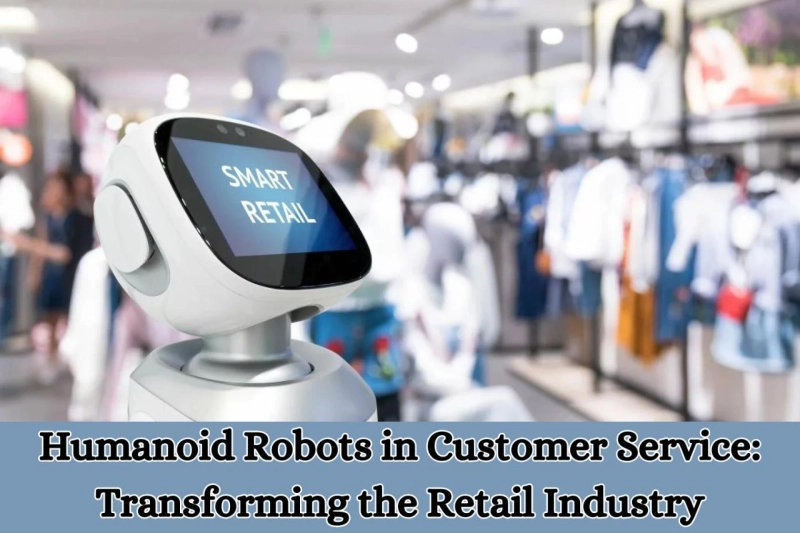The Rise of Humanoid Robots in Customer Service
In recent years, the retail industry has witnessed a remarkable transformation with the rise of humanoid robots in customer service. With the rapid advancement of technology, these robots have become increasingly humanlike in their features and movements, making them an integral part of the retail landscape.
Gone are the days of traditional customer service representatives who were solely responsible for attending to customers' needs. Today, humanoid robots have taken over this role, offering a new and enhanced level of customer service. These humanoid robots are equipped with advanced artificial intelligence (AI) and machine learning capabilities that enable them to understand and respond to customers' inquiries just like humans.
The increasing use of humanoid robots in customer service is not without its reasons. One of the main benefits that these robots offer is efficiency. With physical stores being open for only a limited amount of time, it can be challenging to attend to every customer's needs promptly. However, with humanoid robots in place, retailers can ensure 24/7 availability and quick responses to queries. This leads to improved customer satisfaction and retention.
Moreover, the use of humanoid robots also reduces human errors that can occur during interactions with customers. These robots are programmed with a vast amount of information regarding products and services offered by retailers, ensuring accurate responses every time. This instills confidence in customers as they receive reliable and consistent information from these robots.
Benefits and Advantages of Using Humanoid Robots in Retail Industry
Enhanced Customer Engagement: Humanoid robots can interact with customers in a friendly and engaging manner, providing information about products, promotions, and store layout. Their human-like appearance and communication abilities contribute to a more personalized and immersive shopping experience.Implementing Humanoid Robots in Different Aspects of Customer Service
Information and Assistance: Humanoid robots can be stationed in retail stores, malls, or service centers to provide customers with information about products, services, promotions, and store layouts. These robots can guide customers to specific locations, answer frequently asked questions, and offer personalized recommendations based on customer preferences and purchasing history.Checkout and Payment Processing: Humanoid robots equipped with advanced scanning and payment technology can streamline the checkout process by assisting customers with self-service checkouts and contactless payment options. This automation can reduce waiting times, minimize human errors, and enhance the overall efficiency of the payment process.
Customer Support and Issue Resolution: Humanoid robots can be programmed to address customer inquiries, concerns, and complaints. By utilizing natural language processing and artificial intelligence, these robots can offer effective solutions, troubleshoot common issues, and escalate complex problems to human representatives when necessary. This improves the responsiveness of customer support and ensures a prompt resolution of customer issues.
Product Recommendations and Personalization: Humanoid robots can leverage customer data and preferences to provide personalized product recommendations and suggestions. By analyzing customer behavior and purchase history, these robots can offer tailored product options, promotions, and upselling opportunities, enhancing the relevance of customer interactions and driving sales.
Customer Engagement and Entertainment: Humanoid robots can engage customers through interactive games, quizzes, or entertainment activities, creating a memorable and enjoyable shopping experience. These engaging interactions not only increase customer satisfaction but also foster brand loyalty and encourage repeat visits to the store or service center.
Challenges and Limitations of Using Humanoid Robots in Retail Settings
High Initial Investment Costs: The development, deployment, and maintenance of humanoid robots can involve significant upfront costs, including the expenses associated with hardware, software, programming, and customization. These initial investment costs can be a deterrent for some businesses, especially smaller retailers with limited financial resources.
Impact on the Future Workforce – Will Humanoid Robots Replace Humans?
Automation of Routine Tasks: Humanoid robots are primarily designed to automate repetitive and predictable tasks, thereby allowing human workers to focus on more complex and creative responsibilities. By delegating mundane and monotonous tasks to robots, businesses can optimize their workforce's productivity and creativity, leading to the development of more fulfilling and intellectually stimulating job roles for human employees.Augmentation of Human Capabilities: Humanoid robots can complement human capabilities by performing tasks that require precision, accuracy, and consistency. Through the collaboration of humans and robots, businesses can leverage the strengths of both entities to achieve higher levels of productivity, innovation, and problem-solving, leading to the creation of new job opportunities that capitalize on the integration of human skills with advanced technologies.
Shift in Job Roles and Skill Requirements: The integration of humanoid robots and automation may lead to a transformation of job roles and the demand for a different set of skills in the workforce. While some traditional roles may become obsolete, new positions may emerge that require expertise in robot programming, maintenance, data analysis, and strategic decision-making. This shift highlights the importance of continuous education, training, and upskilling to prepare the workforce for the changing demands of the evolving labor market.
Human-Centric Roles and Services: Certain industries and sectors, such as healthcare, hospitality, and customer service, rely heavily on human interaction, empathy, and emotional intelligence. Humanoid robots are more likely to augment human capabilities in these industries, enhancing the quality of service and improving overall customer experiences, rather than replacing human workers entirely.
You can also read:
edureka data science course review
edureka data science course review


